Layered Double Hydroxides as a Drug Delivery Vehicle for S-Allyl-Mercapto-Cysteine (SAMC)
Abstract
:1. Introduction
2. Materials and Methods
2.1. Materials
2.2. Synthesis of LDH
2.3. Intercalation of S-Allyl-Mercapto-Cysteine into LDH (LDH-SAMC)
2.4. Release Study of SAMC from LDH-SAMC
2.5. Characterization
2.6. Cell Cultures
2.7. Cellular Treatments
2.8. Analysis of Cell Viability (Cytotoxicity)
2.9. Cell Migration Assay Using the Scratch Test
3. Results and Discussion
3.1. Preparation and Characterization of LDH-SAMC
3.2. SAMC Release Studies from LDH-SAMC
3.3. Cytotoxicity of the LDH-SAMC and SAMC Treatments
3.4. Treatment of HepG2 Cells with the LDH-SAMC Complex Enhanced the Inhibition of Tumor Migration
4. Conclusions
Author Contributions
Funding
Institutional Review Board Statement
Informed Consent Statement
Data Availability Statement
Acknowledgments
Conflicts of Interest
References
- Prescott, L.F. The need for improved drug delivery in clinical practice. In Novel Drug Delivery and Its Therapeutic Application; Prescott, L.F., Nimmo, W.S., Eds.; John Wiley and Sons: West Susset, UK, 1989; pp. 1–11. ISBN 0-471-92154-8. [Google Scholar]
- Patra, J.K.; Das, G.; Fraceto, L.F.; Campos, E.V.R.; del Pilar Rodriguez-Torres, M.; Acosta-Torres, L.S.; Diaz-Torres, L.A.; Grillo, R.; Swamy, M.K.; Sharma, S.; et al. Nano Based Drug Delivery Systems: Recent Developments and Future Prospects. J. Nanobiotechnol. 2018, 16, 71. [Google Scholar] [CrossRef] [PubMed] [Green Version]
- Wu, J.; Liu, L.; Cai, Y.; Yao, J. Recent Advances of Calcium Phosphate Nanoparticles for Controlled Drug Delivery. MRMC 2013, 13, 1501–1507. [Google Scholar] [CrossRef]
- Kalimuthu, K.; Lubin, B.-C.; Bazylevich, A.; Gellerman, G.; Shpilberg, O.; Luboshits, G.; Firer, M.A. Gold Nanoparticles Stabilize Peptide-Drug-Conjugates for Sustained Targeted Drug Delivery to Cancer Cells. J. Nanobiotechnol. 2018, 16, 34. [Google Scholar] [CrossRef] [PubMed]
- Kumar, A.; Zhang, X.; Liang, X.-J. Gold Nanoparticles: Emerging Paradigm for Targeted Drug Delivery System. Biotechnol. Adv. 2013, 31, 593–606. [Google Scholar] [CrossRef]
- Liu, Z.; Robinson, J.T.; Tabakman, S.M.; Yang, K.; Dai, H. Carbon Materials for Drug Delivery & Cancer Therapy. Mater. Today 2011, 14, 316–323. [Google Scholar] [CrossRef]
- Iturrioz-Rodríguez, N.; Correa-Duarte, M.A.; Fanarraga, M.L. Controlled Drug Delivery Systems for Cancer Based on Mesoporous Silica Nanoparticles. Int. J. Nanomed. 2019, 14, 3389–3401. [Google Scholar] [CrossRef] [Green Version]
- Vangijzegem, T.; Stanicki, D.; Laurent, S. Magnetic Iron Oxide Nanoparticles for Drug Delivery: Applications and Characteristics. Expert Opin. Drug Deliv. 2019, 16, 69–78. [Google Scholar] [CrossRef]
- Riaz, U.; Ashraf, S.M. Double Layered Hydroxides as Potential Anti-Cancer Drug Delivery Agents. Mini Rev. Med. Chem. 2013, 13, 522–529. [Google Scholar] [CrossRef]
- Yan, L.; Gonca, S.; Zhu, G.; Zhang, W.; Chen, X. Layered Double Hydroxide Nanostructures and Nanocomposites for Biomedical Applications. J. Mater. Chem. B. 2019, 7, 5583–5601. [Google Scholar] [CrossRef] [Green Version]
- Ameena Shirin, V.K.; Sankar, R.; Johnson, A.P.; Gangadharappa, H.V.; Pramod, K. Advanced Drug Delivery Applications of Layered Double Hydroxide. J. Control. Release 2021, 330, 398–426. [Google Scholar] [CrossRef]
- Wen, J.; Yang, K.; Huang, J.; Sun, S. Recent Advances in LDH-Based Nanosystems for Cancer Therapy. Mater. Des. 2021, 198, 109298. [Google Scholar] [CrossRef]
- Ladewig, K.; Xu, Z.P.; Lu, G.Q. (Max) Layered Double Hydroxide Nanoparticles in Gene and Drug Delivery. Expert Opin. Drug Deliv. 2009, 6, 907–922. [Google Scholar] [CrossRef]
- Jin, W.; Ha, S.; Myung, J.-H.; Kim, B.C.; Park, D.-H. Ceramic Layered Double Hydroxide Nanohybrids for Therapeutic Applications. J. Korean Ceram. Soc. 2020, 57, 597–607. [Google Scholar] [CrossRef]
- Ahmed, A.A.A.; Talib, Z.A.; bin Hussein, M.Z.; Zakaria, A. Zn–Al Layered Double Hydroxide Prepared at Different Molar Ratios: Preparation, Characterization, Optical and Dielectric Properties. J. Solid State Chem. 2012, 191, 271–278. [Google Scholar] [CrossRef]
- Guo, X.; Zhang, F.; Evans, D.G.; Duan, X. Layered Double Hydroxide Films: Synthesis, Properties and Applications. Chem. Commun. 2010, 46, 5197. [Google Scholar] [CrossRef] [PubMed]
- Feitknecht, W.; Gerber, M. Zur Kenntnis Der Doppelhydroxyde Und Basischen Doppelsalze III. Über Magnesium-Aluminiumdoppelhydroxyd. Helv. Chim. Acta 1942, 25, 131–137. [Google Scholar] [CrossRef]
- Di Vona, M.L.; Casciola, M.; Donnadio, A.; Nocchetti, M.; Pasquini, L.; Narducci, R.; Knauth, P. Anionic Conducting Composite Membranes Based on Aromatic Polymer and Layered Double Hydroxides. Int. J. Hydrogen Energy 2017, 42, 3197–3205. [Google Scholar] [CrossRef]
- De Roy, A.; Forano, C.; Besse, J.P. Layered double hydroxides: Synthesis and post-synthesis modification. In Layered Double Hydroxides: Present and Future; Rives, V., Ed.; Nova Science Publishers, Inc.: New York, NY, USA, 2001; pp. 1–39. ISBN 978-1-63482-212-1. [Google Scholar]
- Cavani, F.; Trifirò, F.; Vaccari, A. Hydrotalcite-Type Anionic Clays: Preparation, Properties and Applications. Catal. Today 1991, 11, 173–301. [Google Scholar] [CrossRef]
- Arrabito, G.; Bonasera, A.; Prestopino, G.; Orsini, A.; Mattoccia, A.; Martinelli, E.; Pignataro, B.; Medaglia, P.G. Layered Double Hydroxides: A Toolbox for Chemistry and Biology. Crystals 2019, 9, 361. [Google Scholar] [CrossRef] [Green Version]
- Laipan, M. Functionalized Layered Double Hydroxides for Innovative Applications. Mater. Horiz. 2019, 31, 715–745. [Google Scholar] [CrossRef]
- Richetta, M.; Digiamberardino, L.; Mattoccia, A.; Medaglia, P.G.; Montanari, R.; Pizzoferrato, R.; Scarpellini, D.; Varone, A.; Kaciulis, S.; Mezzi, A.; et al. Surface Spectroscopy and Structural Analysis of Nanostructured Multifunctional (Zn, Al) Layered Double Hydroxides: XPS and UPS Investigation of Nanostructured Multifunctional LDH. Surf. Interface Anal. 2016, 48, 514–518. [Google Scholar] [CrossRef] [Green Version]
- Pizzoferrato, R.; Ciotta, E.; Ferrari, I.V.; Braglia, M.; Medaglia, P.G.; Mattoccia, A.; Di Giamberardino, L.; Richetta, M.; Knauth, P.; Di Vona, M.L. Ionic Conductivity of Zn Al Layered Double Hydroxide Films Grown on Aluminum Substrate. Solid State Ion. 2018, 314, 30–35. [Google Scholar] [CrossRef]
- Costantino, U.; Ambrogi, V.; Nocchetti, M.; Perioli, L. Hydrotalcite-like Compounds: Versatile Layered Hosts of Molecular Anions with Biological Activity. Microporous Mesoporous Mater. 2008, 107, 149–160. [Google Scholar] [CrossRef]
- Costantino, U.; Nocchetti, M.; Sisani, M.; Vivani, R. Recent Progress in the Synthesis and Application of Organically Modified Hydrotalcites. Z. Für Krist. 2009, 224, 273–281. [Google Scholar] [CrossRef]
- Prestopino, G.; Arrabito, G.; Generosi, A.; Mattoccia, A.; Paci, B.; Perez, G.; Verona-Rinati, G.; Medaglia, P.G. Emerging Switchable Ultraviolet Photoluminescence in Dehydrated Zn/Al Layered Double Hydroxide Nanoplatelets. Sci. Rep. 2019, 9, 11498. [Google Scholar] [CrossRef]
- Pagano, C. Folic Acid-Layered Double Hydroxides Hybrids in Skin Formulations—Technological, Photochemical and in Vitro Cytotoxicity on Human Keratinocytes and Fibroblasts. Appl. Clay Sci. 2019, 14, 382–389. [Google Scholar] [CrossRef]
- Sels, B.F.; De Vos, D.E.; Jacobs, P.A. Hydrotalcite-like Anionic Clays in Catalytic Organic Reactions. Catal. Rev. 2001, 43, 443–488. [Google Scholar] [CrossRef]
- Di Fronzo, A.; Pirola, C.; Comazzi, A.; Galli, F.; Bianchi, C.L.; Di Michele, A.; Vivani, R.; Nocchetti, M.; Bastianini, M.; Boffito, D.C. Co-Based Hydrotalcites as New Catalysts for the Fischer–Tropsch Synthesis Process. Fuel 2014, 119, 62–69. [Google Scholar] [CrossRef]
- Wang, Y.; Yan, D.; El Hankari, S.; Zou, Y.; Wang, S. Recent Progress on Layered Double Hydroxides and Their Derivatives for Electrocatalytic Water Splitting. Adv. Sci. 2018, 5, 1800064. [Google Scholar] [CrossRef]
- Wang, K.; Wang, T.; Islam, Q.A.; Wu, Y. Layered Double Hydroxide Photocatalysts for Solar Fuel Production. Chin. J. Catal. 2021, 42, 1944–1975. [Google Scholar] [CrossRef]
- Chen, H.; Zhang, F.; Fu, S.; Duan, X. In Situ Microstructure Control of Oriented Layered Double Hydroxide Monolayer Films with Curved Hexagonal Crystals as Superhydrophobic Materials. Adv. Mater. 2006, 18, 3089–3093. [Google Scholar] [CrossRef]
- Cao, K.; Yu, Z.; Zhu, L.; Yin, D.; Chen, L.; Jiang, Y.; Wang, J. Fabrication of Superhydrophobic Layered Double Hydroxide Composites to Enhance the Corrosion-Resistant Performances of Epoxy Coatings on Mg Alloy. Surf. Coat. Technol. 2021, 407, 126763. [Google Scholar] [CrossRef]
- Zubair, M.; Daud, M.; McKay, G.; Shehzad, F.; Al-Harthi, M.A. Recent Progress in Layered Double Hydroxides (LDH)-Containing Hybrids as Adsorbents for Water Remediation. Appl. Clay Sci. 2017, 143, 279–292. [Google Scholar] [CrossRef]
- Chaillot, D.; Bennici, S.; Brendlé, J. Layered Double Hydroxides and LDH-Derived Materials in Chosen Environmental Applications: A Review. Environ. Sci. Pollut. Res. 2021, 28, 24375–24405. [Google Scholar] [CrossRef]
- Tang, Z.; Qiu, Z.; Lu, S.; Shi, X. Functionalized Layered Double Hydroxide Applied to Heavy Metal Ions Absorption: A Review. Nanotechnol. Rev. 2020, 9, 800–819. [Google Scholar] [CrossRef]
- Pizzoferrato, R.; Ciotta, E.; Ferrari, I.V.; Narducci, R.; Pasquini, L.; Varone, A.; Richetta, M.; Antonaroli, S.; Braglia, M.; Knauth, P.; et al. Layered Double Hydroxides Containing an Ionic Liquid: Ionic Conductivity and Use in Composite Anion Exchange Membranes. ChemElectroChem 2018, 5, 2781–2788. [Google Scholar] [CrossRef]
- Sajid, M.; Sajid Jillani, S.M.; Baig, N.; Alhooshani, K. Layered Double Hydroxide-Modified Membranes for Water Treatment: Recent Advances and Prospects. Chemosphere 2021, 287, 132140. [Google Scholar] [CrossRef]
- Zhou, Y. Applications of Two-Dimensional Layered Nanomaterials in Photoelectrochemical Sensors: A Comprehensive Review. Coord. Chem. Rev. 2021, 48, 214156. [Google Scholar] [CrossRef]
- Sohrabi, H.; Khataee, A.; Ghasemzadeh, S.; Majidi, M.R.; Orooji, Y. Layer Double Hydroxides (LDHs)-Based Electrochemical and Optical Sensing Assessments for Quantification and Identification of Heavy Metals in Water and Environment Samples: A Review of Status and Prospects. Trends Environ. Anal. Chem. 2021, 31, e00139. [Google Scholar] [CrossRef]
- Tomassetti, M.; Pezzilli, R.; Prestopino, G.; Natale, C.D.; Medaglia, P.G. Fabrication and Characterization of a Layered Double Hydroxide Based Catalase Biosensor and a Catalytic Sensor for Hydrogen Peroxide Determination. Microchem. J. 2021, 106700. [Google Scholar] [CrossRef]
- Polese, D.; Mattoccia, A.; Giorgi, F.; Pazzini, L.; Di Giamberardino, L.; Fortunato, G.; Medaglia, P.G. A Phenomenological Investigation on Chlorine Intercalated Layered Double Hydroxides Used as Room Temperature Gas Sensors. J. Alloys Compd. 2017, 692, 915–922. [Google Scholar] [CrossRef]
- Munyemana, J.C.; Chen, J.; Han, Y.; Zhang, S.; Qiu, H. A Review on Optical Sensors Based on Layered Double Hydroxides Nanoplatforms. Microchim. Acta 2021, 188, 80. [Google Scholar] [CrossRef]
- Tadanaga, K.; Furukawa, Y.; Hayashi, A.; Tatsumisago, M. Direct Ethanol Fuel Cell Using Hydrotalcite Clay as a Hydroxide Ion Conductive Electrolyte. Adv. Mater. 2010, 22, 4401–4404. [Google Scholar] [CrossRef] [PubMed]
- Gao, X.; Wang, P.; Pan, Z.; Claverie, J.P.; Wang, J. Recent Progress in Two-Dimensional Layered Double Hydroxides and Their Derivatives for Supercapacitors. ChemSusChem 2020, 13, 1226–1254. [Google Scholar] [CrossRef]
- Boumeriame, H.; Da Silva, E.S.; Cherevan, A.S.; Chafik, T.; Faria, J.L.; Eder, D. Layered Double Hydroxide (LDH)-Based Materials: A Mini-Review on Strategies to Improve the Performance for Photocatalytic Water Splitting. J. Energy Chem. 2021, 64, 406–431. [Google Scholar] [CrossRef]
- Zhang, Y.; Xu, H.; Lu, S. Preparation and Application of Layered Double Hydroxide Nanosheets. RSC Adv. 2021, 11, 24254–24281. [Google Scholar] [CrossRef]
- Taviot-Guého, C.; Prévot, V.; Forano, C.; Renaudin, G.; Mousty, C.; Leroux, F. Tailoring Hybrid Layered Double Hydroxides for the Development of Innovative Applications. Adv. Funct. Mater. 2018, 28, 1703868. [Google Scholar] [CrossRef]
- Rives, V.; del Arco, M.; Martín, C. Intercalation of Drugs in Layered Double Hydroxides and Their Controlled Release: A Review. Appl. Clay Sci. 2014, 88–89, 239–269. [Google Scholar] [CrossRef]
- Costantino, U.; Nocchetti, M. Layered double hydroxides and their intercalation compounds in photochemistry and in medicinal chemistry. In Layered Double Hydroxides: Present and Future; Rives, V., Ed.; Nova Science Publishers, Inc.: New York, NY, USA, 2001; pp. 435–468. ISBN 978-1-63482-212-1. [Google Scholar]
- Chatterjee, A.; Bharadiya, P.; Hansora, D. Layered Double Hydroxide Based Bionanocomposites. Appl. Clay Sci. 2019, 177, 19–36. [Google Scholar] [CrossRef]
- Wei, M.; Guo, J.; Shi, Z.; Yuan, Q.; Pu, M.; Rao, G.; Duan, X. Preparation and Characterization of L-Cystine and l-Cysteine Intercalated Layered Double Hydroxides. J. Mater. Sci. 2007, 42, 2684–2689. [Google Scholar] [CrossRef]
- Dasgupta, P.; Bhattacharya, A.; Pal, R.; Dasgupta, A.K.; Sengupta (Bandyopadhayay), S. Synthesis of Diallyl Disulfide (DADS) Induced Gold Nanoparticles: Characterization and Study of Its Biological Activity in Human Leukemic Cell-Lines. RSC Adv. 2015, 5, 18429–18437. [Google Scholar] [CrossRef]
- Ramachandran, E.; Natarajan, S. Crystal Growth of Some Urinary Stone Constituents: III. In-Vitro Crystallization of L-Cystine and Its Characterization. Cryst. Res. Technol. 2004, 39, 308–312. [Google Scholar] [CrossRef]
- Nikolić, V.D.; Ilić, D.P.; Nikolić, L.B.; Stanković, M.Z.; Stanojević, L.P.; Savić, I.M.; Savić, I.M. The synthesis and structure characterization of deoxyalliin and alliin. Adv. Technol. 2012, 9, 38–46. [Google Scholar]
- Liang, D. S-Allylmercaptocysteine Effectively Inhibits the Proliferation of Colorectal Cancer Cells under in Vitro and in Vivo Conditions. Cancer Lett. 2011, 8, 69–76. [Google Scholar] [CrossRef] [PubMed]
- Zhang, Y.; Li, H.-Y.; Zhang, Z.-H.; Bian, H.-L.; Lin, G. Garlic-Derived Compound S-Allylmercaptocysteine Inhibits Cell Growth and Induces Apoptosis via the JNK and P38 Pathways in Human Colorectal Carcinoma Cells. Oncol. Lett. 2014, 8, 2591–2596. [Google Scholar] [CrossRef] [PubMed] [Green Version]
- Xiao, D.; Pinto, J.T.; Soh, J.-W.; Deguchi, A.; Gundersen, G.G.; Palazzo, A.F.; Yoon, J.-T.; Shirin, H.; Weinstein, I.B. Induction of Apoptosis by the Garlic-Derived Compound S-Allylmercaptocysteine (SAMC) Is Associated with Microtubule Depolymerization and c-Jun NH2-Terminal Kinase 1 Activation. Cancer Res. 2003, 63, 6825–6837. [Google Scholar] [PubMed]
- Shirin, H.; Pinto, J.T.; Kawabata, Y.; Soh, J.-W.; Delohery, T.; Moss, S.F.; Murty, V.; Rivlin, R.S.; Holt, P.R.; Weinstein, I.B. Antiproliferative Effects of S-Allylmercaptocysteine on Colon Cancer Cells When Tested Alone or in Combination with Sulindac Sulfide. Cancer Res. 2001, 61, 725–731. [Google Scholar]
- Sigounas, G.; Hooker, J.; Anagnostou, A.; Steiner, M. S-allylmercaptocysteine Inhibits Cell Proliferation and Reduces the Viability of Erythroleukemia, Breast, and Prostate Cancer Cell Lines. Nutr. Cancer 1997, 27, 186–191. [Google Scholar] [CrossRef] [PubMed]
- Kaschula, C.H.; Hunter, R.; Cotton, J.; Tuveri, R.; Ngarande, E.; Dzobo, K.; Katz, A.A.; Parker, M.I. The Garlic Compound Ajoene Targets Protein Folding in the Endoplasmic Reticulum of Cancer Cells. Mol. Carcinog. 2016, 55, 1213–1228. [Google Scholar] [CrossRef]
- Bastianini, M.; Costenaro, D.; Bisio, C.; Marchese, L.; Costantino, U.; Vivani, R.; Nocchetti, M. On the Intercalation of the Iodine–Iodide Couple on Layered Double Hydroxides with Different Particle Sizes. Inorg. Chem. 2012, 51, 2560–2568. [Google Scholar] [CrossRef]
- Strober, W. Trypan Blue Exclusion Test of Cell Viability. Curr. Protoc. Immunol. 2015, 111. [Google Scholar] [CrossRef] [PubMed]
- Pantanowitz, L.; Miller, K.B.; Ford, J.C.; Beckwith, B.A. The scratch test. Arch. Pathol. Lab. Med. 2004, 128, 598. [Google Scholar] [CrossRef]
- Chai, H.; Xu, X.; Lin, Y.; Evans, D.G.; Li, D. Synthesis and UV Absorption Properties of 2,3-Dihydroxynaphthalene-6-Sulfonate Anion-Intercalated Zn–Al Layered Double Hydroxides. Polym. Degrad. Stab. 2009, 94, 744–749. [Google Scholar] [CrossRef]
- Wei, M.; Pu, M.; Guo, J.; Han, J.; Li, F.; He, J.; Evans, D.G.; Duan, X. Intercalation of l-Dopa into Layered Double Hydroxides: Enhancement of Both Chemical and Stereochemical Stabilities of a Drug through Host−Guest Interactions. Chem. Mater. 2008, 20, 5169–5180. [Google Scholar] [CrossRef]
- Parida, K.M. Synthesis and Characterization of a Fe(III)-Schiff Base Complex in a Zn-Al LDH Host for Cyclohexane Oxidation. Chemical 2010, 6, 7–12. [Google Scholar] [CrossRef]
- Feng, Y.; Li, D.; Wang, Y.; Evans, D.G.; Duan, X. Synthesis and Characterization of a UV Absorbent-Intercalated Zn–Al Layered Double Hydroxide. Polym. Degrad. Stab. 2006, 91, 789–794. [Google Scholar] [CrossRef]
- Arizaga, G.G.C.; da Costa Gardolinski, J.E.F.; Schreiner, W.H.; Wypych, F. Intercalation of an Oxalatooxoniobate Complex into Layered Double Hydroxide and Layered Zinc Hydroxide Nitrate. J. Colloid Interface Sci. 2009, 330, 352–358. [Google Scholar] [CrossRef]
- Benício, L.P.F.; Eulálio, D.; Guimarães, L.D.M.; Pinto, F.G.; Costa, L.M.D.; Tronto, J. Layered Double Hydroxides as Hosting Matrices for Storage and Slow Release of Phosphate Analyzed by Stirred-Flow Method. Mater. Res. 2018, 21. [Google Scholar] [CrossRef]
- Clause, O.; Gazzano, M.; Trifiro, F.; Vaccari, A.; Zatorski, L. Preparation and Thermal Reactivity of Nickel/Chromium and Nickel/Aluminium Hydrotalcite-Type Precursors. Appl. Catal. 1991, 73, 217–236. [Google Scholar] [CrossRef]
- Rastogi, L. Green Synthetic Route For The Size Controlled Synthesis Of Biocompatible Gold Nanoparticles Using Aqueous Extract Of Garlic (Allium Sativum). Adv. Mater. Lett. 2013, 4, 548–555. [Google Scholar] [CrossRef]
- Socrates, G. Infrared and Raman Characteristic Group Frequencies: Tables and Charts, 3rd ed.; Wiley, C.J., Ed.; Wiley: New York, NY, USA, 2004; ISBN 978-0-470-09307-8. [Google Scholar]
- Ramaswamy, S.; Rajaram, R.K.; Ramakrishnan, V. Infrared and Laser Raman Spectra of Bis(DL-Methioninium) Sulfate. J. Raman Spectrosc. 2005, 36, 840–847. [Google Scholar] [CrossRef]
- Rezvani, Z.; Arjomandi Rad, F.; Khodam, F. Synthesis and Characterization of Mg–Al-Layered Double Hydroxides Intercalated with Cubane-1,4-Dicarboxylate Anions. Dalton Trans. 2015, 44, 988–996. [Google Scholar] [CrossRef]
- Nakayama, H.; Wada, N.; Tsuhako, M. Intercalation of Amino Acids and Peptides into Mg–Al Layered Double Hydroxide by Reconstruction Method. Int. J. Pharm. 2004, 269, 469–478. [Google Scholar] [CrossRef]
- Minagawa, K.; Berber, M.R.; Hafez, I.H.; Mori, T.; Tanaka, M. Target Delivery and Controlled Release of the Chemopreventive Drug Sulindac by Using an Advanced Layered Double Hydroxide Nanomatrix Formulation System. J. Mater. Sci. Mater. Med. 2012, 23, 973–981. [Google Scholar] [CrossRef]
- Khan, S.B.; Alamry, K.A.; Alyahyawi, N.A.; Asiri, A.M.; Arshad, M.N.; Marwani, H.M. Nanohybrid Based on Antibiotic Encapsulated Layered Double Hydroxide as a Drug Delivery System. Appl. Biochem. Biotechnol. 2015, 175, 1412–1428. [Google Scholar] [CrossRef]
- Liu, J.; Song, J.; Xiao, H.; Zhang, L.; Qin, Y.; Liu, D.; Hou, W.; Du, N. Synthesis and Thermal Properties of ZnAl Layered Double Hydroxide by Urea Hydrolysis. Powder Technol. 2014, 253, 41–45. [Google Scholar] [CrossRef]
- Inayat, A.; Klumpp, M.; Schwieger, W. The Urea Method for the Direct Synthesis of ZnAl Layered Double Hydroxides with Nitrate as the Interlayer Anion. Appl. Clay Sci. 2011, 51, 452–459. [Google Scholar] [CrossRef]
- Xiao, J.; Xing, F.; Liu, Y.; Lv, Y.; Wang, X.; Ling, M.-T.; Gao, H.; Ouyang, S.; Yang, M.; Zhu, J.; et al. Garlic-Derived Compound S-Allylmercaptocysteine Inhibits Hepatocarcinogenesis through Targeting LRP6/Wnt Pathway. Acta Pharm. Sin. B 2018, 8, 575–586. [Google Scholar] [CrossRef]

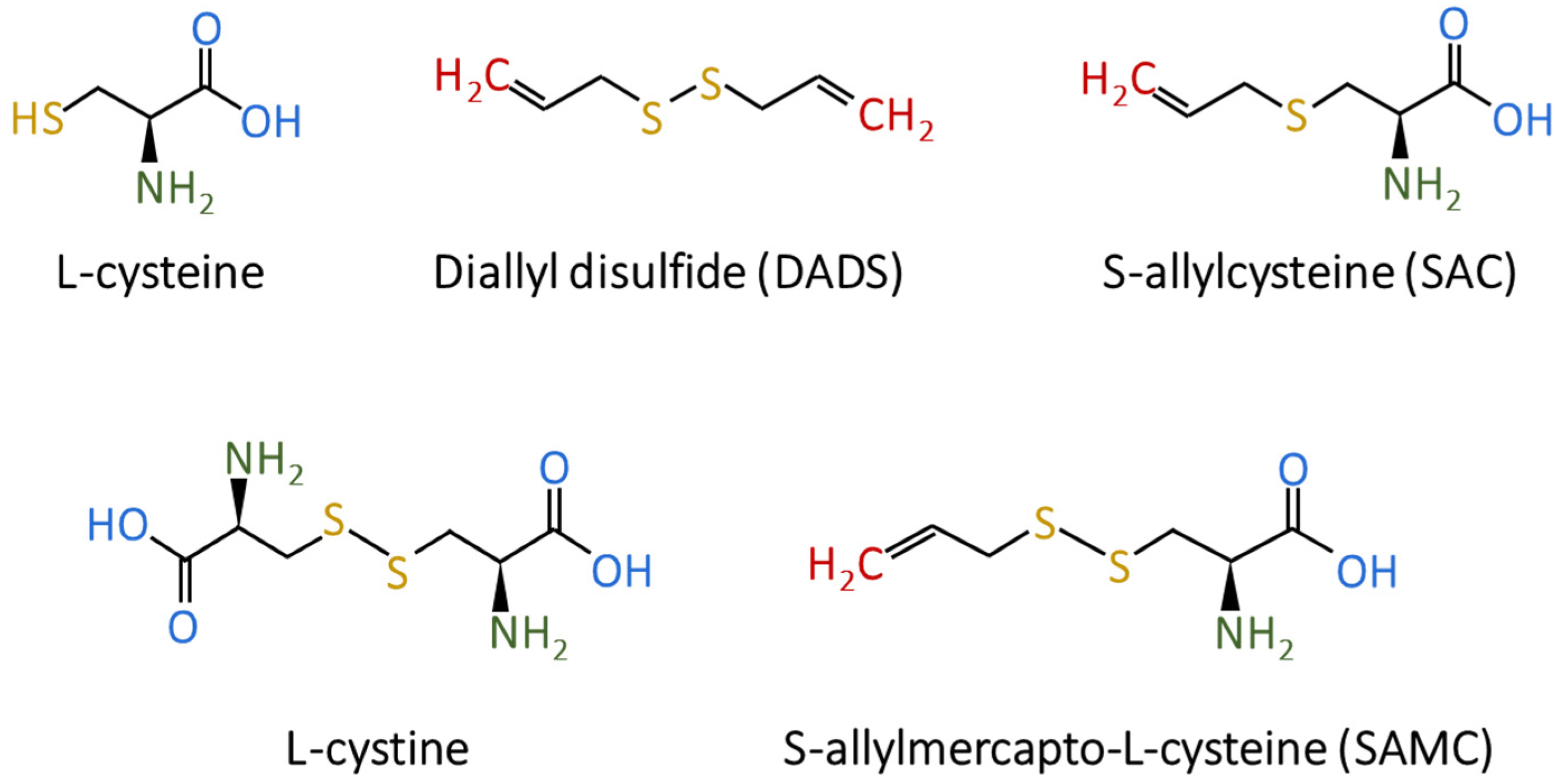

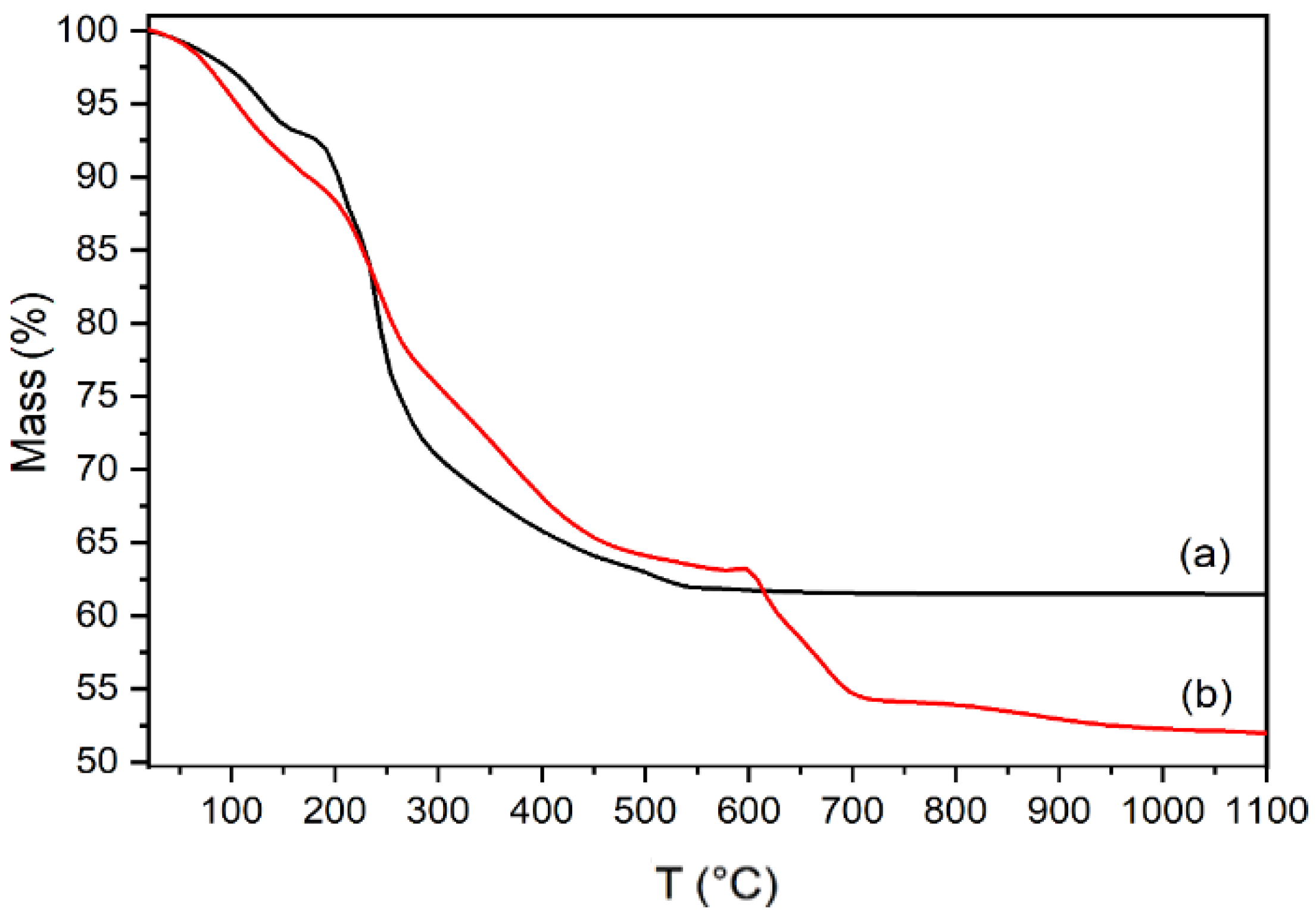
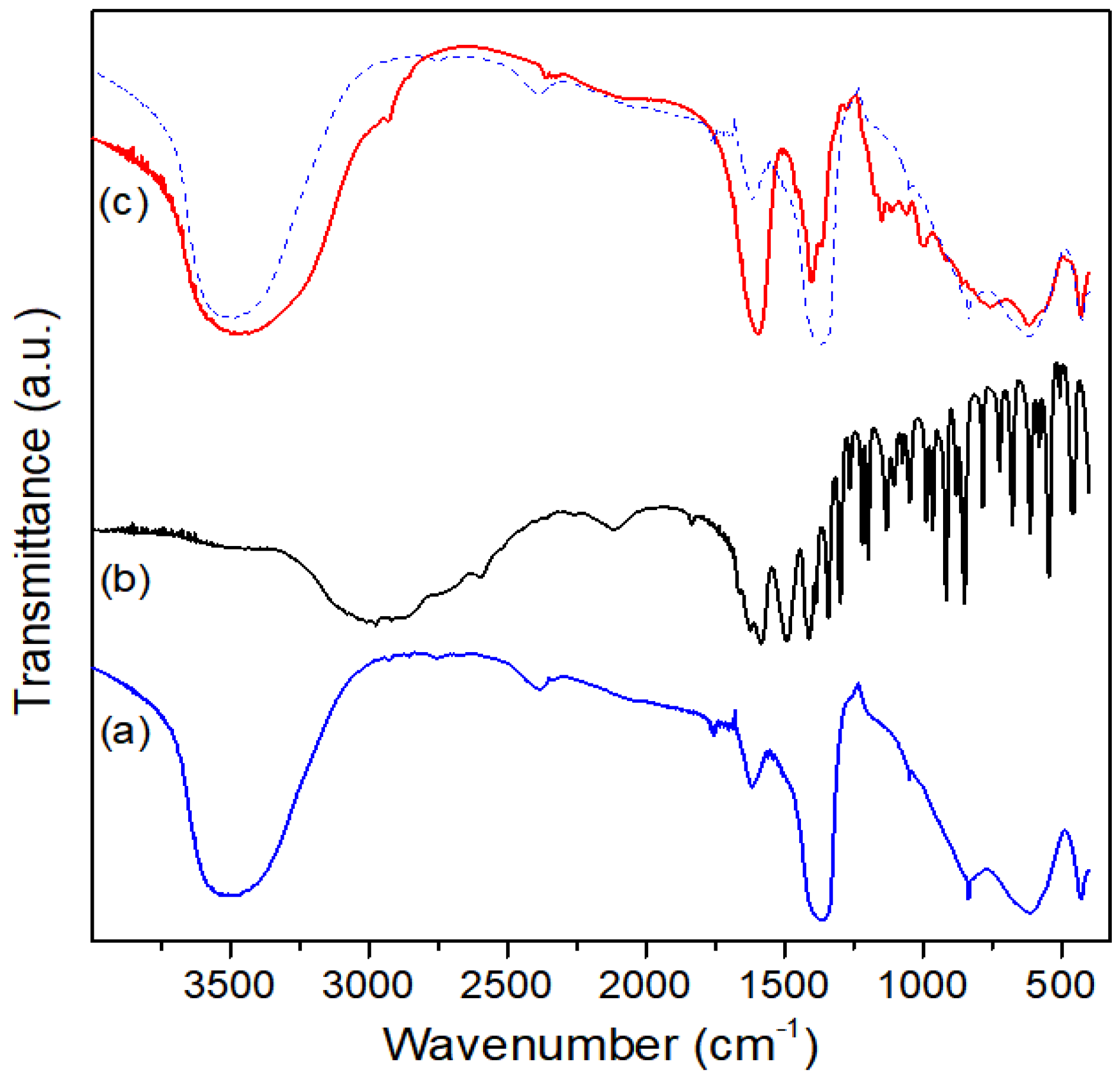

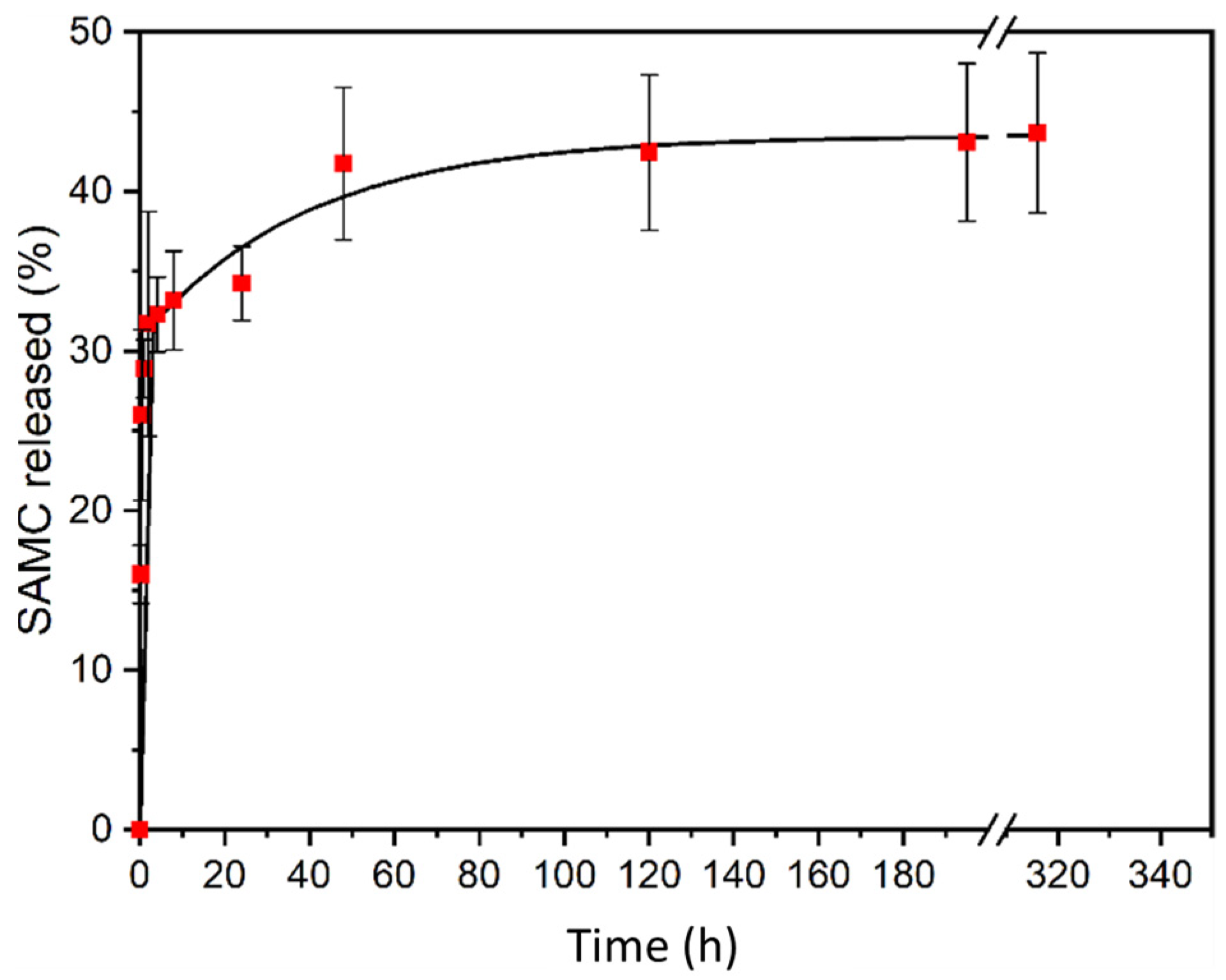
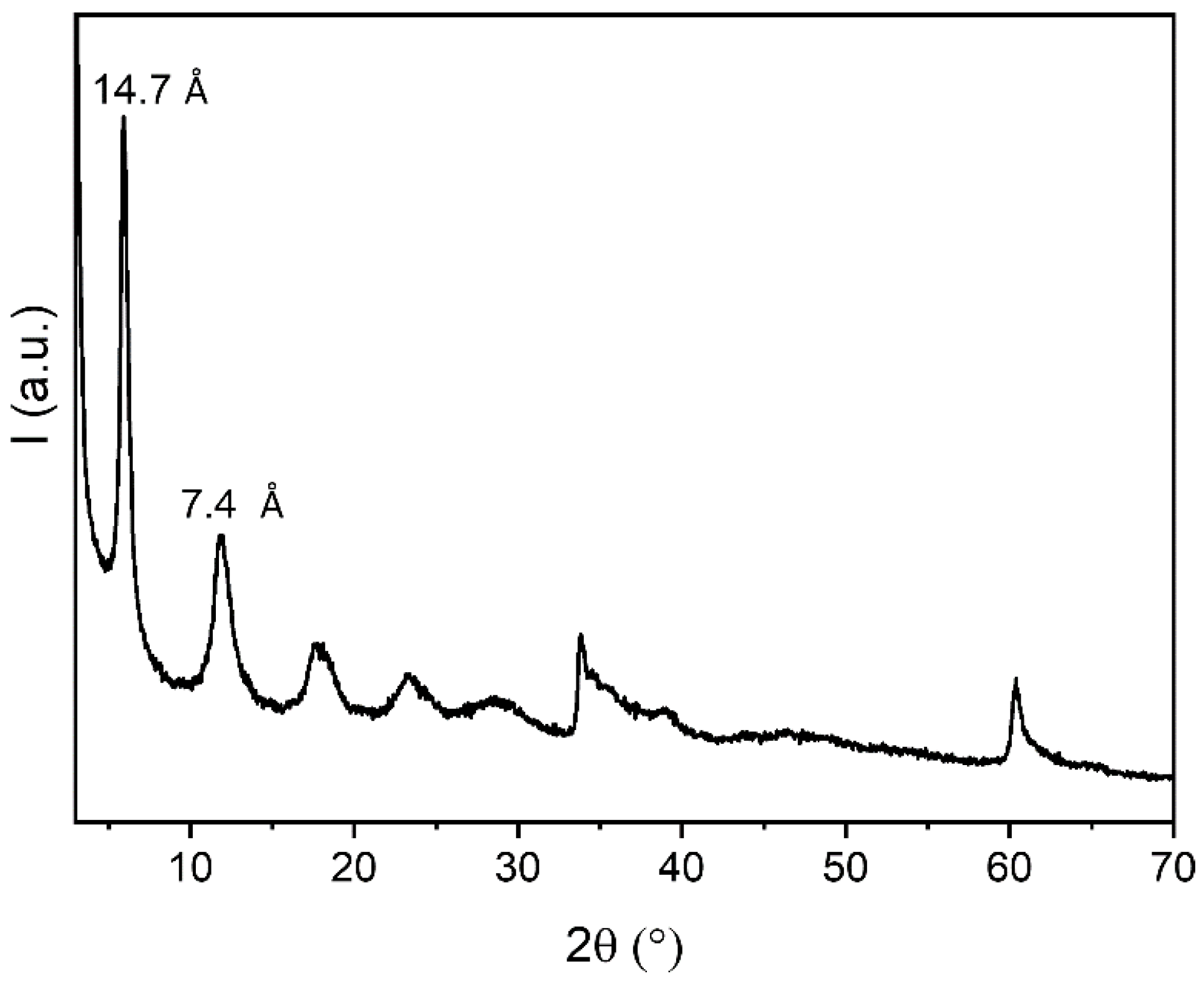
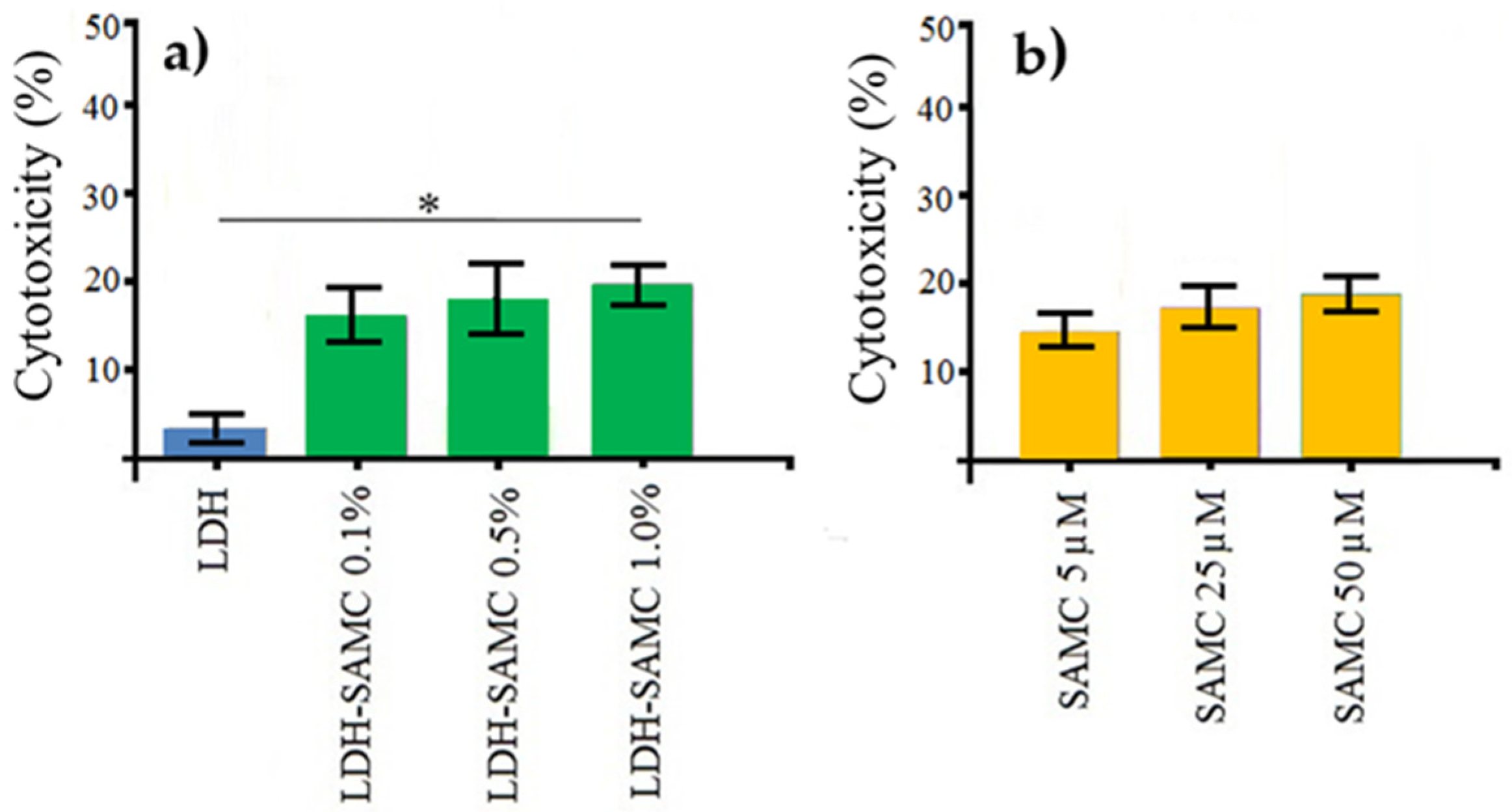
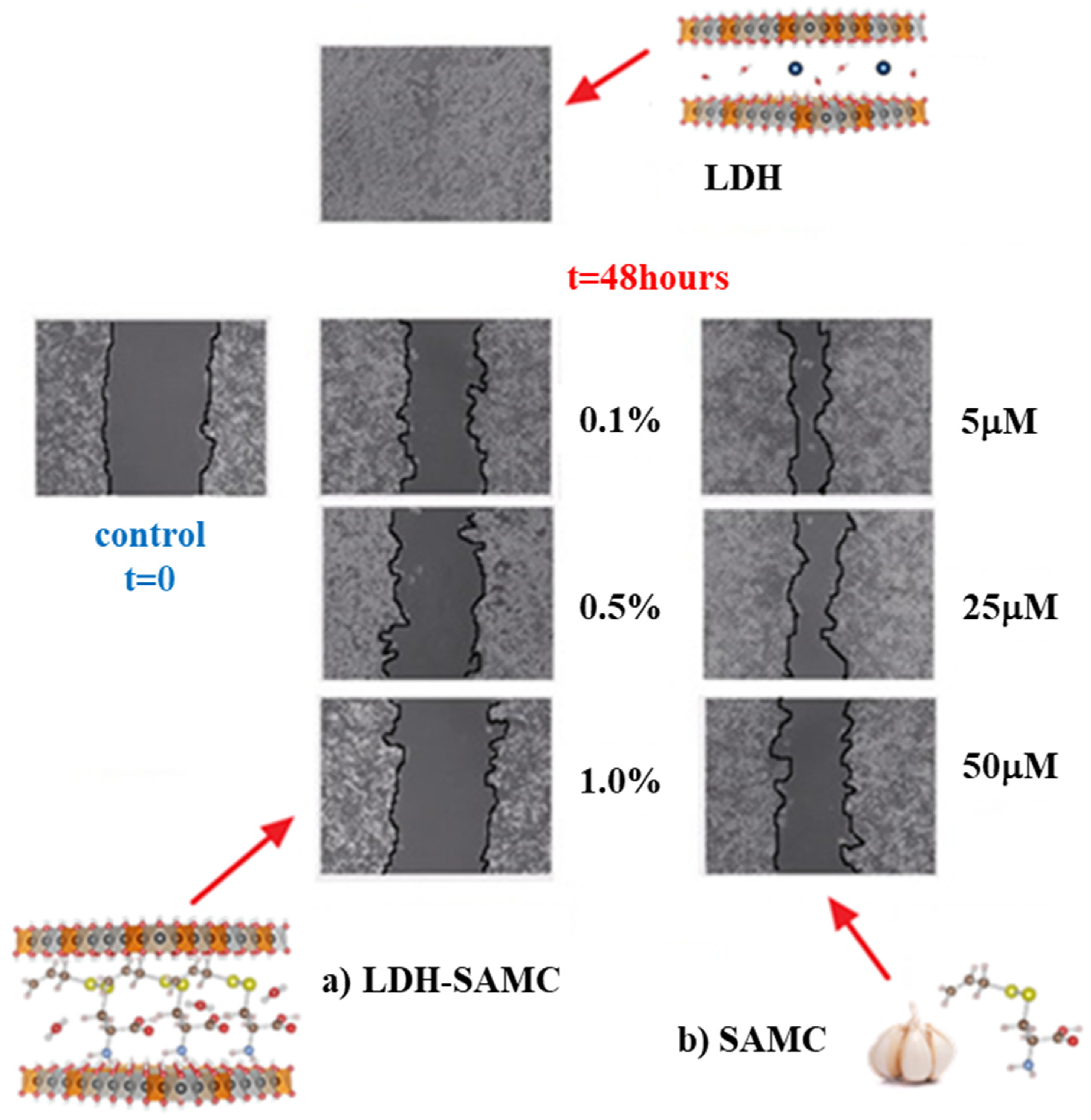

Publisher’s Note: MDPI stays neutral with regard to jurisdictional claims in published maps and institutional affiliations. |
© 2021 by the authors. Licensee MDPI, Basel, Switzerland. This article is an open access article distributed under the terms and conditions of the Creative Commons Attribution (CC BY) license (https://creativecommons.org/licenses/by/4.0/).
Share and Cite
Ferrari, I.V.; Narducci, R.; Prestopino, G.; Costantino, F.; Mattoccia, A.; Di Giamberardino, L.; Nocchetti, M.; Di Vona, M.L.; Paolone, A.; Bini, M.; et al. Layered Double Hydroxides as a Drug Delivery Vehicle for S-Allyl-Mercapto-Cysteine (SAMC). Processes 2021, 9, 1819. https://doi.org/10.3390/pr9101819
Ferrari IV, Narducci R, Prestopino G, Costantino F, Mattoccia A, Di Giamberardino L, Nocchetti M, Di Vona ML, Paolone A, Bini M, et al. Layered Double Hydroxides as a Drug Delivery Vehicle for S-Allyl-Mercapto-Cysteine (SAMC). Processes. 2021; 9(10):1819. https://doi.org/10.3390/pr9101819
Chicago/Turabian StyleFerrari, Ivan Vito, Riccardo Narducci, Giuseppe Prestopino, Ferdinando Costantino, Alessio Mattoccia, Lina Di Giamberardino, Morena Nocchetti, Maria Luisa Di Vona, Annalisa Paolone, Marzia Bini, and et al. 2021. "Layered Double Hydroxides as a Drug Delivery Vehicle for S-Allyl-Mercapto-Cysteine (SAMC)" Processes 9, no. 10: 1819. https://doi.org/10.3390/pr9101819
APA StyleFerrari, I. V., Narducci, R., Prestopino, G., Costantino, F., Mattoccia, A., Di Giamberardino, L., Nocchetti, M., Di Vona, M. L., Paolone, A., Bini, M., Pezzilli, R., Borromeo, I., Beninati, S., & Medaglia, P. G. (2021). Layered Double Hydroxides as a Drug Delivery Vehicle for S-Allyl-Mercapto-Cysteine (SAMC). Processes, 9(10), 1819. https://doi.org/10.3390/pr9101819














